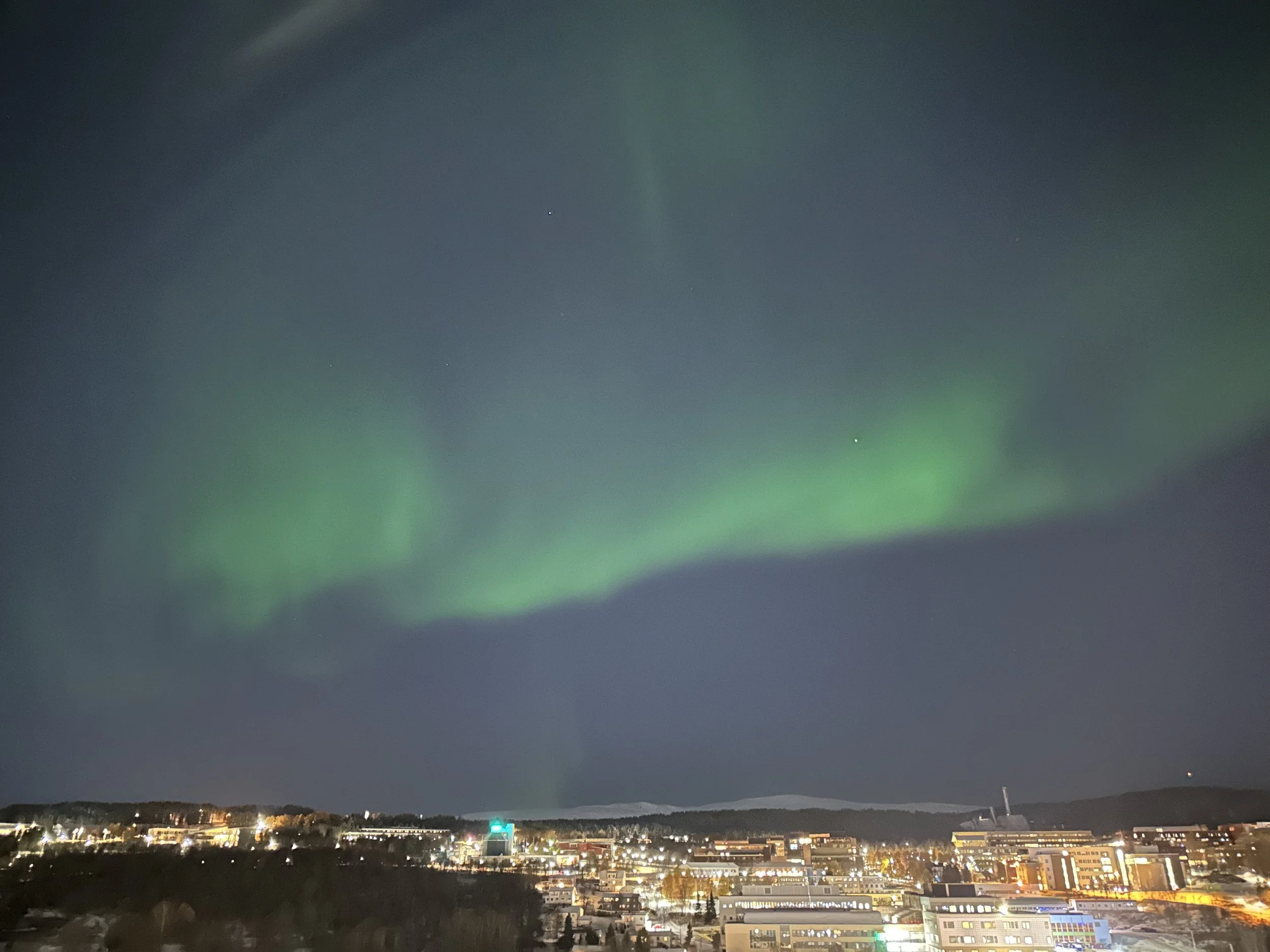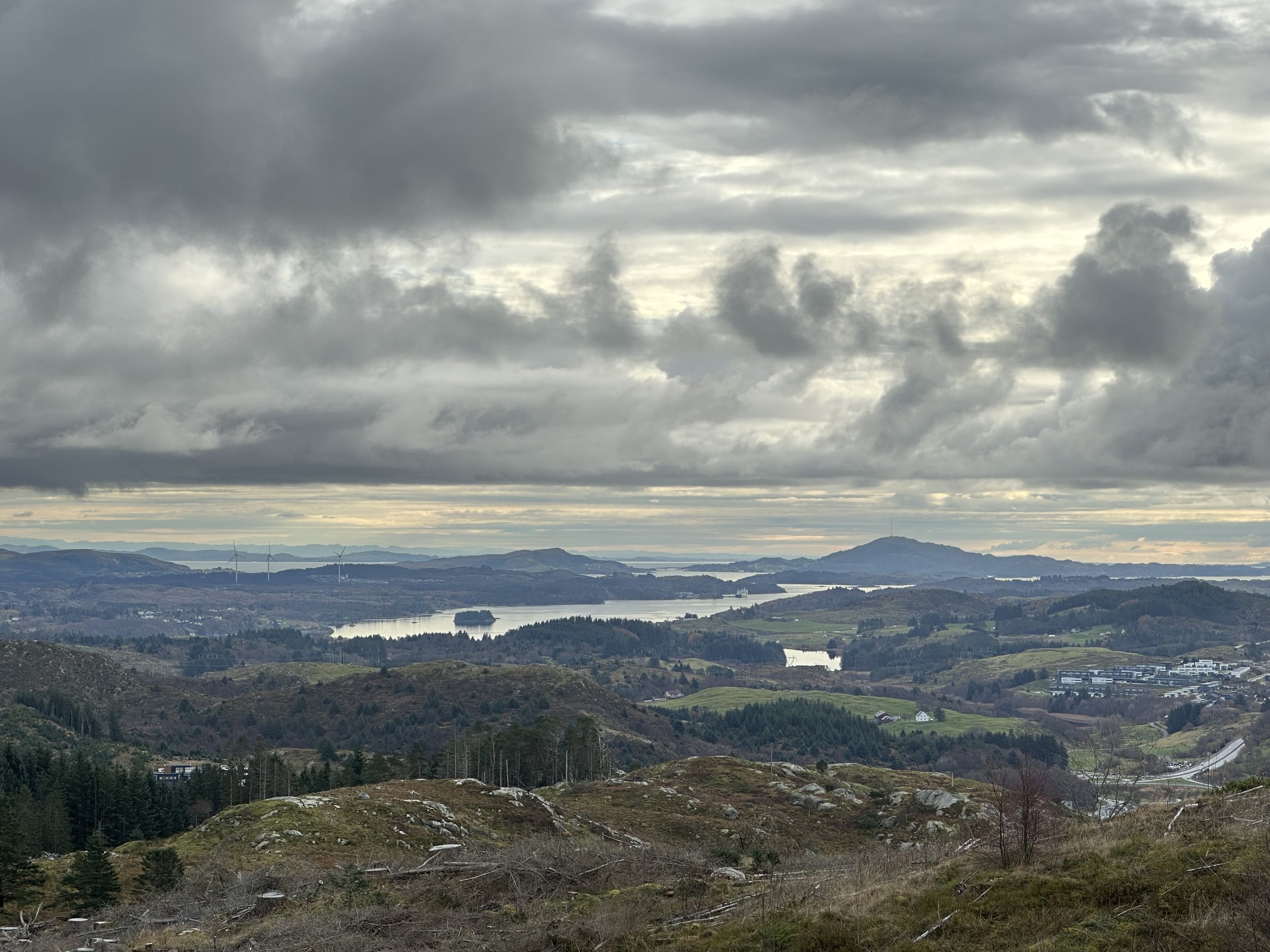Norway Oct 27, 2023
Rare red and green Northern Lights seen from the ship
Norway is one of the countries best seen by ship seeing how it’s long and narrow with a beautiful coastline. It was my first trip to Norway, Candy had been to Oslo prior. This was our chance to traverse the North Sea, see the fjords and hopefully, if lucky enough, see the Northern Lights. We boarded the Cunard Queen Victoria and left Southampton spending our first two days at sea. The North Sea can be rough, and it was. Fortunately, it didn’t last too long. I took no medications along the way and was delighted to not feel any effects of the high waves. In my youth I would get terribly sea sick just crossing a bay or fishing in a calm Lake Michigan. I’d read somewhere that people can lose their sensitivity to motion sickness as they get older. Count me among them. One of the few things where your body improves with age.
Alesund
Our first stop was the southern Norway town of Alesund. This is a smaller city situated on an island at the mouth of several fjords. Like many Norwegian towns it was originally built of wood and in 1904 it burnt to the ground. Kaiser Wilhelm who vacationed often by royal yacht on the coast of Norway, was quick to send four ships full of materials to help rebuild it. The town’s appreciative citizens named a main street and dedicated a park and memorial to him. Today the stone architecture of the rebuilt town is a highlight. While in Alesund we took a boat ride south through the Storfjorden fjord. It was a great way to spend a couple hours just gliding through a quiet and natural setting. Here and there we saw small villages nestled to the shoreline below the steep mountainsides on both shores. Roads are still limited and many residents travel by their own boat or where possible a ferry.
Alesund
Storfjorden
The town of Bjørke at the far end of the fjord
Leaving Alesund we cruised north across the Arctic Circle and docked at the city of Tromso. The town center is small and there were some nice coffee shops and clothing stores. The sidewalks were icy so we didn’t wander too far. Later a bus ride through the hills made for some great views, but there weren’t any stops to take photos. This little urban area claims to be the northernmost city in the world. As we were only a few weeks away from the start of the polar night, the sun didn’t climb very far over the horizon. Tromso is also famous for a WWII story. The German battleship Tirpitz, sister ship to the Bismark, raided convoys from a nearby naval base up the northern coast. Damaged by air raids and unable to risk further sorties, she was anchored just off shore from Tromso to serve as a floating battery and protect against any allied invasion. Not long after, and very late in the war, high level RAF bombers would remove any threat, and sank the ship in its moorings. Mostly sold for scrap, portions of it still lie in the coastal waters for interested divers.
Tromso
Mid afternoon Tromso
Evening Tromso
From Tromso we made our way south to Narvik. To this point we’d still not seen so much as a smidge of the Northern Lights. Some of that was due to poor luck and some I think the presence of a near full moon. In addition the towns and ships lights didn’t help much. Before we left Tromso, there was a group excursion into the countryside at night to a dark sky location in the hope of catching a glimpse, but our shipmates told us there was nothing to be seen.
The iron ore business is still thriving at Narvik
Docked at Narvik
In Narvik we walked into town and visited the local history museum. Then there was a bus trip north into the countryside. Our destination was a another small museum that held examples of the Norwegian fishing boats, clothing and gear used over the centuries. Compared to the high tech ships we saw in port, it was amazing to see what these Viking blooded norsemen went through to make a catch and make a living. Later we took a night bus trip to catch the Northern Lights and it turned up empty, but we did see some nice stars standing outside in the cold.
Stopped at a small fishing village for a bite
The Northern Norwegian Boat Museum north of Narvik
Narvik has a more recent history. It was here in 1940 that a battle took place. You may have seen the movie on Netflix. In the Winter of 39/40, between the fall of Poland and the invasion of France, the world was watching Narvik. An important source of iron ore, not just to Germany but to England came from Kiruna in Sweden. The ore mines surrounding that area shipped this supply by rail to Narvik which was just a few miles west and the closest harbor. On a side note, all the main harbors in Norway are ice free year round due to the warmer ocean currents. That Spring, both sides had merchant ships in the busy harbor loading out with ore. Both sides wanted to control the supply. For the Germans, contrary to what we might have learned, the preference was for Norway to remain neutral. This would allow German ships to load out at Narvik and travel nearly all the way to Germany within the protection of neutral Norway’s territorial waters. Churchill being the “man of action” he was, decided to tip the balance. He mined the Norwegian waters off Narvik to impede the German’s path. This was actually an act of war against Norway. Hitler now seeing that he had to act, decided to invade Norway’s principal ports in a bold strike. However, the Germans, hoping to gain the cooperation of Norway arrived postured as “protectors” of Norway’s sovereignty. They wanted the ore and if possible some northern naval bases (thinking ahead to war with Russia), but there was nothing else strategic about it.
The Norwegians, with a few boats and a very small but brave army saw otherwise. They immediately refused. There would be no discussion. They drew from what they had and opened fire. Most of Norway’s ports collapsed to German marines and paratroopers. But Narvik was another story. With the arrival of the British navy, and then thousands of British and French soldiers, they fought on. They recaptured the town, then cut off and drove the German troops into the mountains. It was the first Allied victory of WWII. A hard fought and bloody one that lasted months. Then for some reason not clear to anyone, the British pulled out of Norway and gave Narvik back to the Germans. It remained in their hands until VE day. So this dramatic victory by the Allies went for nought, but today is still remembered with pride by the locals. The remains of German destroyers sunk in the harbor and the areas of heavy fighting are still marked. Those Norwegians we talked to, from bus drivers, to local guides knew the battle in great detail, all these years later.
A slice of the armor belt from the KMS Tirpitz preserved at Narvik War Museum
Remnants of the lost ships at Battle of Narvik displayed at Narvik’s excellent War Museum
Salvaged from the aft plate of a German destroyer that was sunk in the battle
Leaving Narvik we headed further south along the coast to our last port of call, Haugesund. Along the way there were a series of announcements on the ship’s PA. The Northern Lights were spotted. People rushed to the decks from dinner, cameras in tow. Even without a true dark sky we could see them. It turns out there was a major display going on in Europe, in fact they were even seen as far south as Italy. The luck that eluded us further north now reversed. We were in the right place at the right time and my iphone camera was up to the task. No tripod needed.
The lights are normally green, but the display was so significant that uncommon red and purple colors mixed in.
Haugesund had prospered and grew quickly as a center of the fishing industry. At one time herring were prevalent in the area, although today they are long gone and the petroleum industry has taken over. There are a number of beautiful old homes in town that were built by the wealthy owners of the fishing companies. We took a tour into the hills above the town. I think outside of the fjord cruise, it was the best excursion of the trip. The area around the city was once a Viking center and most believe it was from these shores that the famous Viking Rollo led raids to England and northern Europe. He would go on to establish Normandy. Also near here, there was an important sea battle fought offshore around 900 AD that was part of the earliest unification of Norway. Near a memorial to the battle, we climbed a small hill to see an old medieval stone cross. There are some 60 similar crosses in the area dating from when Christianity first found Norway. Their purpose is a not well established. Were they a place of worship while churches were built? Perhaps memorials to some event that took place at that spot. The guide said they believed they were placed along the coast to demonstrate to those sailing by that the location was inhabited by Christians.
Above Haugesund
The thousand year old stone cross named Krosshaugen.
From Haugesund we headed back to Southampton this time with calm seas. The trip checked off my list both the desire to see the Northern Lights and to finally visit Norway. I made note when we were in Tromso that they have direct flights to Svalbard island in the arctic where the Polar Bears roam. That might make for a nice adventure at some future date.





























